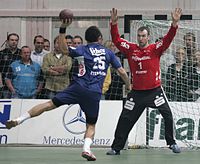
Photo from wikipedia
There are many adult studies reporting static stretch (SS)-induced deficits and dynamic stretch (DS) performance improvements shortly after the intervention. However, there is only a single study examining stretch-induced performance… Click to show full abstract
There are many adult studies reporting static stretch (SS)-induced deficits and dynamic stretch (DS) performance improvements shortly after the intervention. However, there is only a single study examining stretch-induced performance changes with youth at 24 hours’ post-stretch. The objective of this study was to examine physiological responses of young trained athletes at 24-hours after experiencing SS or DS protocols. Eight young male, elite handball players (age: 16.1±5.1 years) were tested prior to-, 3-minutes and 24-hours following the three conditions (DS, SS, Control) in a randomized and counterbalanced order. Similar volumes of SS (2 repetitions of 75s for each leg) and DS (5 repetitions of 30s for each leg) involved one stretch each for the quadriceps and hamstrings. Tests included (i) two 4s maximal voluntary isometric contractions (MVC) at 60° of knee flexion with 2-min rest, (ii) two maximal isokinetic contractions each at 60°/sec and 300°/sec with 1-min rest, and (iii) two drop jumps with 30-sec rest. To simulate a full warm-up, dynamic activity including 5 minutes of aerobic cycling (70 rpm; 1 kilopond), 4 submaximal isometric contractions and 4 drop jumps were instituted before the pre-tests and following the interventions. Two-way repeated measures ANOVAs revealed that 1) both the SS and control conditions exhibited knee extensor 60°.s-1 (SS:-10.3%; p = 0.04, Control: -8.7%; p = 0.07) and 300°.s-1 (SS: -12.9%; p = 0.005, Control: -16.3%; p = 0.02) isokinetic deficits at post-test, 2) DS impaired knee flexor 60°.s-1 isokinetic work and power-related measures at post-test (Work: -10.1%; p = 0.0006; Power: -19.1%; p = 0.08) and at 24-hours’ post-test (Work: 9.9%; p = 0.023; Power: -9.6%; p = 0.01), 3) DS (12.07% and 10.47%) and SS (13.7% and 14.6%) enhanced knee flexor 300°.s-1 isokinetic force and power-related measures compared to control. In conclusion, testing-induced knee extensor isokinetic impairments were counterbalanced by DS, however the hip flexion DS could have produced minor muscle damage for at least 24-hours decreasing knee flexor forces and power at 60°.s-1.
Journal Title: PLoS ONE
Year Published: 2019
Link to full text (if available)
Share on Social Media: Sign Up to like & get
recommendations!